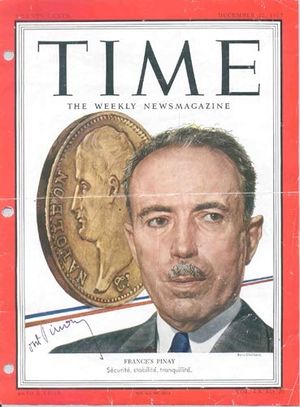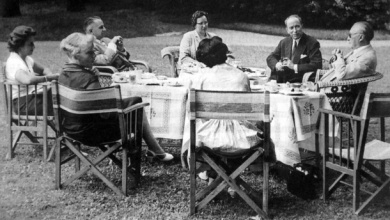Antoine Pinay
( politician, deep politician) | |||||||||||||||||||||||||||||||||||||||||||||||||||||||||||||||||||
|---|---|---|---|---|---|---|---|---|---|---|---|---|---|---|---|---|---|---|---|---|---|---|---|---|---|---|---|---|---|---|---|---|---|---|---|---|---|---|---|---|---|---|---|---|---|---|---|---|---|---|---|---|---|---|---|---|---|---|---|---|---|---|---|---|---|---|---|
 | |||||||||||||||||||||||||||||||||||||||||||||||||||||||||||||||||||
| Born | 30 December 1891 Saint-Symphorien-sur-Coise, Rhône, France | ||||||||||||||||||||||||||||||||||||||||||||||||||||||||||||||||||
| Died | 13 December 1994 (Age 102) Saint-Chamond, Loire, France | ||||||||||||||||||||||||||||||||||||||||||||||||||||||||||||||||||
| Nationality | French | ||||||||||||||||||||||||||||||||||||||||||||||||||||||||||||||||||
| Member of | Le Cercle | ||||||||||||||||||||||||||||||||||||||||||||||||||||||||||||||||||
| Interest of | Robert André, Henri Yrissou | ||||||||||||||||||||||||||||||||||||||||||||||||||||||||||||||||||
| Party | Democratic Republican Alliance, Democratic and Radical Union, Independent Radicals, Independent, CNIP, Union for the New Republic | ||||||||||||||||||||||||||||||||||||||||||||||||||||||||||||||||||
Multi-Bilderberg French deep politician, chairman and eponymous head of the Pinay Cercle
| |||||||||||||||||||||||||||||||||||||||||||||||||||||||||||||||||||
Antoine Pinay was a French deep politician, Operation Gladio operative and Prime Minister of France. He worked closely with another deep politician, Jean Violet. He made a lasting contribution to the establishment of the European Deep state, and then the Supranational Deep State through helping to set up the deep state milieux originally known as the Pinay Circle, although his right hand man, Violet was more active in setting it up.
Contents
Biography
Antoine Pinay was born in Saint-Symphorien-sur-Coise. He was child of Claude Pinay and his wife, Marie Antoinette Besson. On 25 April 1917, Pinay married Marguerite Fouletier and had two daughters and one son, Geneviève (1918–2017), Odette (1920–2015), and Pierre (1922–1964). As a young man, Pinay fought in World War I and injured his arm so that it was paralyzed for the rest of his life.
Career
After WWI, he managed a small business and in 1929 he was elected mayor of Saint-Chamond in the Loire prefecture.
Interwar politics
He was elected to the Chamber of Deputies in 1936, running as an independent candidate opposed to the left wing Popular Front government. In 1938 he was elected to the Senate, where he joined the Independent Radicals. On 10 July 1940 he voted to give the Cabinet presided over by Marshal Philippe Pétain authority to draw up a new constitution, effectively ending the French Third Republic and establishing Vichy France. In 1941, Antoine Pinay was appointed to the Conseil National of the Vichy Regime, but he resigned from the Conseil National within a few months and refused any official position with the Vichy regime.
After WW2
In 1944, after the liberation, he was first placed on house arrest, and stripped of his right to be candidate to the national election on 5. September 1945. An official commission in 1946 recognized his opposition to the Nazis and the help he gave to the Resistance, and let him totally free of any charge.
He helped create a conservative party, the National Center of Independents and Peasants (CNIP) in 1949. He acquired the reputation as one of France's more spirited politicians, and in 1952 became Prime Minister by virtue of being the most popular elected CNIP official, and possible U.S. support. His ministry was seen as the return of the "classical right", discredited since the liberation.
Deep politics
Pinay was one of the main French officials in the stay-behind networks, the NATO clandestine army.[1] In 1955, he was one of the participants of the Messina Conference, which would lead to the European Economic Community foundation, the Treaty of Rome in 1957.
“Apart from his distinguished career in public office, Antoine Pinay had other less obvious attributes. Convinced of the need for Franco-German reconciliation, Pinay would create a network of contacts that would finally take form as the Cercle Pinay; via the select club of Bilderbergers, Pinay had easy access to the top figures in international politics and finance.”
David Teacher [2]
He was a candidate for the presidency of the Republic in 1953. In 1955, he was Minister of Foreign Affairs and allowed the independence of Morocco and paved the way for Tunisian autonomy (as long as they accepted French dominance).
During the May 1958 crisis precipitated by the Algerian war, he supported Charles de Gaulle's return to power ('De Gaulle's coup d'etat') and approved the new French constitution, the Fifth Republic. He was French Finance Minister until 1960.
Pinay had senior functions in Opus Dei.[3]
Pinay Cercle
- Full article:
 Le Cercle
Le Cercle
- Full article:

Although did not set it up, Antoine Pinay gave his name to the Pinay Cercle, a deep state milieux of great importance (especially in the development of the "war on terror") which is now just called "Le Cercle".
Two Scandals
In the following years, he one of the originators of the attempts to gather conservative opposition to the (also conservative) de Gaulle. The idea of a Pinay candidacy gained ground, running on a liberal, Atlanticist and pro-European line, likely to bring together right-wing critics of de Gaulle's nationalist politics.
But Antoine Pinay might have been prevented from running by the threat that files from the Ballets roses scandal (a 1959 pedophile scandal) would be used against him, which would have been supported by a police record deposited against him following an alleged "touching of a minor". This political fact, known in political circles, was not brought to the attention of the general public until 2011 with the publication of the book Sexus Politicus.[4]
There is another theory for why he chose not to run: while he left the government after an disagreement with de Gaulle over the development of French nuclear weapons, at the heart of de Gaulle's policy of national independence, an investigation conducted by the intelligence service DST proved that Antoine Pinay was part of the Gehlen network, a a former Nazi spy lord now in the service of the United States, whose goal was to create a network of pro-Atlanticists and to weaken the policy of General de Gaulle.[5]
Antoine Pinay's not running for president opened up the way to other candidates, notably Jean Lecanuet and François Mitterrand, both supported by the United States and discreetly funded thanks to Jean Monnet's connections to the United States.
Trip to South Africa
Pinay travelled to South Africa in 1973, a visit which according to a leaked cable was not understood by the US at the time. He was described in the cable as "aging but still prominent".[6] Later Le Cercle would hold Le Cercle/Meetings in South Africa and received funding from the isolated government, whose deep politicians were eager for close ties with foreign deep state operatives.
Retirement(?)
After abandoning national political ambition, Antoine Pinay devoted himself to his mandate as mayor of Saint-Chamond until 1977, and Member of the (toothless) European Parliament from 1958 to 1979.
Events Participated in
| Event | Start | End | Location(s) | Description |
|---|---|---|---|---|
| Bilderberg/1955 March | 18 March 1955 | 20 March 1955 | France Barbizon | The second Bilderberg meeting, held in France. Just 42 guests, fewer than any other. |
| Bilderberg/1956 | 11 May 1956 | 13 May 1956 | Denmark Fredensborg | The 4th Bilderberg meeting, with 147 guests, in contrast to the generally smaller meetings of the 1950s. Has two Bilderberg meetings in the years before and after |
| Bilderberg/1957 February | 15 February 1957 | 17 February 1957 | US St Simons Island Georgia (State) | The earliest ever Bilderberg in the year, number 5, was also first one outside Europe. |
| Bilderberg/1963 | 29 March 1963 | 31 March 1963 | France Cannes Hotel Martinez | The 12th Bilderberg meeting and the second one in France. |
| Bilderberg/1964 | 20 March 1964 | 22 March 1964 | US Virginia Williamsburg | A year after this meeting, the post of GATT/Director-General was set up, and given Eric Wyndham White, who attended the '64 meeting. Several subsequent holders have been Bilderberg insiders, only 2 are not known to have attended the group. |
| Le Cercle/1958 | 18 August 1958 | 18 August 1958 | Europe | Exact dates uncertain |
| Le Cercle/1970 (Washington) | 2 December 1970 | 2 December 1970 | US Washington DC Rockefeller family mansion | Exact dates uncertain |
| Le Cercle/1977 (South Africa) | 13 May 1977 | 16 May 1977 | South Africa | 4 day Cercle meeting, exposed in 2017 after a report surfaced on the internet |
| Le Cercle/1978 (Tehran) | 3 September 1978 | 3 September 1978 | Iran Tehran | In August 1978 the Shah invited Le Cercle to Tehran |
References
- ↑ Éric Branca, "L'Ami américain"
- ↑ Rogue Agents p. 8
- ↑ https://wikileaksitalian.files.wordpress.com/2021/12/1986-09police-report-on-opus-dei-and-cercle-pinay.pdf
- ↑ Christophe Dubois et Christophe Deloire, Sexus Politicus
- ↑ Éric Branca, "L'Ami américain"
- ↑ https://search.wikileaks.org/plusd/cables/1973PARIS21218_b.html